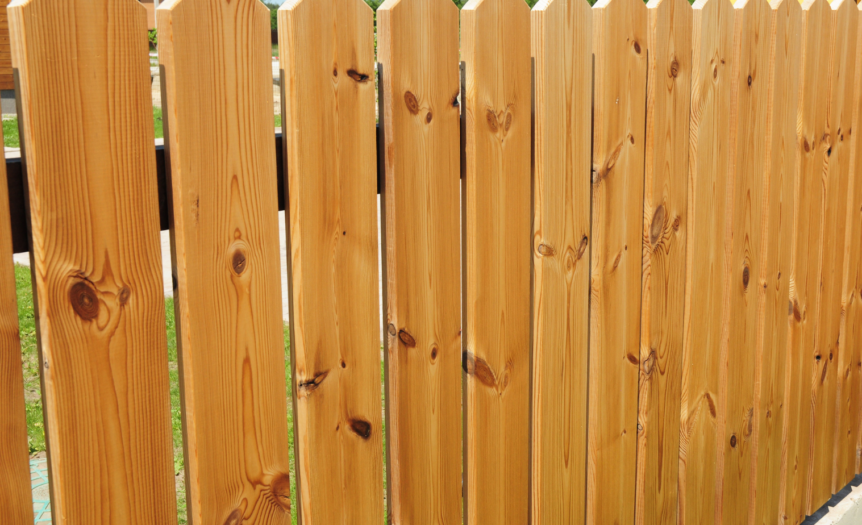A wood fence can be a beautiful, durable, and functional addition to any home or property. However, homeowners often wonder about the lifespan of their fences and how they can prolong it.
The average life of a wood fence ranges from 15 to 20 years with proper care; factors such as type of wood, climate, maintenance practices, and installation quality all play essential roles in determining its longevity.
In this blog post, we’ll break down these elements so that you can make informed decisions when installing a new fence or maintaining your current one.
Understanding The Lifespan Of Wood Fences
To fully understand the lifespan of wood fences, it is important to consider the types of wood used for fencing, compare it with other materials like vinyl and aluminum, and take into account factors such as weather conditions, maintenance, and installation techniques.
Types Of Wood Used For Fencing
Selecting the appropriate wood type for fencing is crucial in determining the durability and lifespan of your fence. Several types of wood are commonly used, each offering distinct advantages and aesthetic appeal.
Cedar is a top choice when it comes to longevity, as it contains natural oils that help resist rotting, decay, and insect infestation.
In addition to cedar, pressure-treated pine is another popular option due to its affordability and resistance to decay. Pressure-treated wood undergoes a process where chemicals are infused into the lumber to deter insects and fungal decay.
This treatment extends the life expectancy of a pine fence up to 25 years with proper maintenance. Other notable choices include redwood or tropical hardwoods like ipe, which boast exceptional strength and visual appeal but come at a higher cost compared with cedar or pressure-treated pine.
Comparison With Other Fencing Materials
When it comes to choosing a fencing material, wood is one of the most popular options due to its affordability and natural look. However, there are several other fencing materials on the market that offer their own unique advantages.
Vinyl and aluminum fences, for example, have longer lifespans than wood fences, with vinyl lasting up to 50 years.
On the other hand, wood fences can provide a greater sense of privacy and security compared to chain-link or wrought-iron fences. Additionally, wood fences can be easily customized with different colors or stains for added style.
Factors Affecting Fence Lifespan
The lifespan of a wood fence is influenced by various factors, including the type of wood used, level of maintenance it receives, and climate. Pressure-treated wood fences tend to last longer than untreated or natural wood fences because they are chemically treated to resist rotting and insect damage.
Regular cleaning and inspection can also extend the life of a wood fence by identifying any issues before they become more severe. Weather conditions can be detrimental to a wooden fence’s lifespan as well.
In areas with high humidity or extreme temperatures, like Florida, fences may have shorter lifespans due to accelerated weathering and decay.
Maximizing The Longevity Of Your Wood Fence
Ensure the longevity of your wood fence by selecting the right type of wood, using proper installation techniques, regularly cleaning and inspecting it, and applying sealants or protective coatings.
Choosing The Right Type Of Wood
Selecting the proper type of wood is crucial when it comes to building a long-lasting fence. Some woods are naturally resistant to decay, pests, and weather conditions while others are not.
Cedar is an excellent choice for fencing because it has natural oils that protect it from rotting and insect damage.
Pressure-treated pine is another option but requires regular maintenance such as staining or painting every few years to extend its lifespan. It’s essential to choose a wood that complements your property’s aesthetic appeal while ensuring its durability against harsh outdoor elements.
Proper Installation Techniques
Proper installation techniques play a crucial role in the lifespan of a wood fence. To ensure the longevity of your fence, it is important to first choose the right type of wood for your needs and climate.
Cedar and redwood are popular choices as they are naturally resistant to decay and insect damage.
In addition, spacing between boards should be consistent to prevent warping and twisting over time. It is also recommended to use stainless steel nails or screws for installation rather than galvanized ones which can corrode and cause damage to the wood over time.
Regular Cleaning And Inspection
Proper maintenance is crucial in maintaining the longevity of your wood fence, and regular cleaning and inspection are essential elements. Dirt, debris, and other outdoor elements can accumulate on your fence over time, causing it to look faded or even allowing rot to set in.
A simple periodic wash with soap and water can keep your fence looking fresh while also preventing decay. Regular inspections are necessary to catch early signs of damage such as warped or cracked boards, which require immediate attention before they lead to larger issues.
By taking care of your wood fence regularly through cleaning and inspections, you’re not only prolonging its lifespan but also improving its appearance. This will save you money by avoiding costly repairs or complete replacements due to neglect over time.
Sealants And Protective Coatings
Sealants and protective coatings can greatly enhance the lifespan of your wood fence. They create a barrier that protects against moisture, sun damage, and other environmental factors that can cause decay or rot.
Staining your fence every 2-3 years with a high-quality stain will help prolong its lifespan by preventing water from penetrating the surface of the wood.
Additionally, applying a sealant after staining or painting adds an extra layer of defense against weathering and UV rays. A clear sealant will maintain the natural appearance of the wood while colored options add a tinted finish for added aesthetic appeal.
The frequency at which you need to apply sealants or coatings depends on your location’s climate and how much sun exposure your fence receives each day.
Overall, investing in regular maintenance such as staining and sealing can increase the lifespan of your wood fence by up to 20% according to industry standards – making them well worth considering as part of proper fencing care practices over time.
Enhancing The Durability Of Your Wood Fence
To keep your wood fence in tip-top shape, proper maintenance and durability measures are essential. From repairing damaged boards to trimming nearby foliage, learn how to enhance the longevity of your wood fence for years to come.
Proper Maintenance Techniques
To maximize the longevity of a wood fence, proper maintenance techniques are crucial. Regular cleaning and inspection are essential to keeping your fence in good condition.
Clear debris, dirt, and leaves away from the base of the fence to prevent moisture buildup and possible rotting.
Staining or painting your wood fence every few years can help protect it from weather damage and prolong its life span.
If any boards become damaged, they should be promptly repaired or replaced as they can compromise the entire structure of the fence.
Overall, attention to detail with regular maintenance is key when it comes to extending a wood fence’s lifespan beyond the average 15-20 year mark.
Weather Protection Measures
To enhance the durability of your wood fence, it is vital to protect it from weathering. Exposure to harsh weather conditions such as wind, sun, and rain can cause the wood to decay or warp quickly.
One way to protect your wooden fence from weather damage is by using sealants or waterproof coatings.
Another useful way to shield your fence’s structure and color against sunlight exposure is staining. Regularly applying a high-quality stain helps slow down the natural aging process of wood fences while preserving their beauty for longer periods.
Finally, keeping foliage trimmed away from your fence reduces moisture exposure and lessens shade buildup that might damage the fencing material over time.
Repairing And Replacing Damaged Boards
Regular maintenance and upkeep are crucial in extending the lifespan of your wood fence, but sometimes despite all efforts, damages can still occur. If a board or two becomes damaged beyond repair, it’s important to replace them immediately to prevent any further damage from spreading.
Start by identifying the areas that need attention and remove any debris or nails around the area. Then measure the dimensions of the board that needs replacement to ensure an accurate fit.
Use a circular saw or nail puller to remove the damaged board before installing a new one using galvanized screws or nails for extra stability.
By regularly inspecting and addressing damages as they occur, you can not only extend the longevity of your wooden fence but also save money on costly repairs in the long run.
Trimming Nearby Foliage
To enhance the durability and longevity of your wood fence, it’s important to trim any nearby foliage regularly. Overgrowth from trees and bushes can cause damage by rubbing against the fence or holding moisture against it, leading to rot and decay.
Regularly trimming nearby foliage is an easy way to prevent these issues from arising. This means cutting back any branches or vines that are touching the fence, as well as removing any plants growing too close to it.
Conclusion
In conclusion, the lifespan of a wood fence can vary depending on several factors, including the type of wood used, level of maintenance received, and location. With proper installation and regular maintenance, a wood fence can last up to 20 years or even more.
Choosing the right type of wood, ensuring proper installation techniques, regular cleaning and inspections, application of sealants and protective coatings are key steps in maximizing your wood fence’s longevity.
Additionally, taking weather protection measures such as staining your fence for longevity or repairing damaged boards promptly can enhance its durability.






